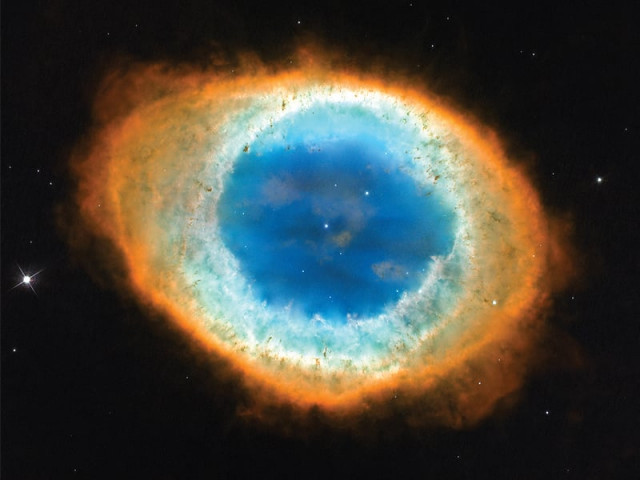Anticipating a glorious death of our Sun
Even the cosmos recycles as the death of a star reveals.

The Ring Nebula as captured by the Hubble Space Telescope. The whole structure in the photograph is about one light year across. SOURCE: NASA, ESA, AND THE HUBBLE HERITAGE (STSCI/AURA)-ESA/HUBBLE COLLABORATION
Now all that is left is a small white nucleus surrounded by gases that once were part of the star itself. Some of these gases will one day be part of another star. This is cosmic recycling at its best.
While beautiful, this stage is temporary for the star. Most of the gases we see in the Ring Nebula were expelled only a few thousand years ago. The star at the time had bloated into a red giant and subsequently lost much of its outer material to space, leaving behind a central core about the size of the Earth. This core is called a white dwarf and is one of the densest objects in the universe. Here on Earth, a teaspoon of white dwarf material would weigh as much as a car.

Made up mostly of Carbon and Oxygen, the white dwarf is extremely hot — about twenty times hotter than the surface of our Sun. It is the light from this white dwarf that is making some of the gases glow in the Ring Nebula. However, it does not have any energy source within, and from now on it will slowly cool down for eternity, becoming dimmer and dimmer each passing year, eventually — no longer detectable in visible light. This is the final stage — the corpse of a star that shone for ten billion years.
This is the fate that awaits the Sun as well. Our star has been a stable source of energy for the past four-and-a-half-billion years. Algae, rodents, ferns, seagulls, ants, humans — they have all been dependent on this supply of energy. Quite amazingly, humans have figured out that our Sun will run out of its supply of fuel in another 5 billion years or so. No need to worry about it tomorrow morning. But if humans — or some form of their descendants — are to survive on scales of billions of years, then journeys to other stars will have to be undertaken. Whatever happens to us, our Sun’s last rites will also include a beautiful nebula followed by the forever cooling of its white dwarf.
What about life around the star that formed the Ring Nebula? We have not detected any planets there as yet and we certainly have no idea if there ever was any life, let alone intelligence, out there. However, if there were any worlds inhabited by complex, intelligent beings, then I hope they had stumbled upon science, figured out the impending death of their star, and made alternative plans. They may have implemented mass-evacuation to another planet around a nearby star system. They may have left a billion years before the death of their star. The beauty of Ring Nebula may now be bitter sweet as they watch the demise of their original home star. Or maybe this life form never developed the ability to leave its solar system. Then most likely all of this life is now gone — just one of many mass extinctions that must happen quite often in the universe.
Salman Hamed is Associate Professor of Integrated Science and Humanities at Hampshire College, Massachusetts, Usa. He runs the blog Irtiqa at Irtiqa-blog.com
Published in The Express Tribune, Sunday Magazine, July 7th, 2013.
Like Express Tribune Magazine on Facebook, follow @ETribuneMag on Twitter to stay informed and join the conversation.



















COMMENTS
Comments are moderated and generally will be posted if they are on-topic and not abusive.
For more information, please see our Comments FAQ